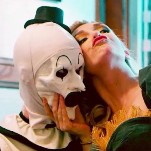You Have GOT to Watch This 1943 Version of The Phantom of the Opera
In DepthIt’s the week before Halloween, and yet it still doesn’t feel like fall. Let’s spend the week catapulting ourselves into the spooky mood by watching holiday-adjacent old movies. I’m sorry, but we’ve all seen Hocus Pocus too damn many times.
There have been many adaptations of Gaston Leroux’s 1910 novel The Phantom of the Opera. But two versions have won out—Lon Chaney’s 1925 silent film and version and Andrew Lloyd Webber 1986 musical. We’re really leaving some incredible takes on the table, however, like the 1943 Universal Pictures clunker starring Claude Rains, which is basically Adam West’s Batman, but specifically for teenage girls. You can rent it on YouTube.
The basic story always stays the same—a masked man becomes obsessed with a talented young opera singer named Christine. But every version makes its own, unique efforts to turn a really weird turn-of-the-century suspense novel into a workable modern romance, and this one’s quirks are really something to behold.
-

-

-

-

-

-

-

-

-

-

-

-

-

-

-

-

-

-

-

-

-

-

-

-

-

-

-

-

-

-

-

-

-

-

-

-

-

-

-

-








































